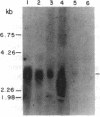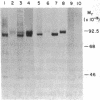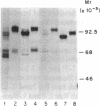Abstract
Factor B and C2 are structurally and functionally similar complement proteins encoded by genes that are closely linked within the class III region of the major histocompatibility complex (MHC). In this study, restriction endonuclease digestion of cosmid DNAs isolated from an H-2d murine genomic library indicated that the chromosomal organization of these two genes was similar in mouse to that in man. To further characterize their expression, cosmid DNAs encoding human and murine factor B and C2 were introduced into mouse L cells by DNA-mediated gene transfer. Factor B expression was demonstrated in cells transfected with either the human or the murine gene, but not in cells transfected with a control plasmid. Synthesis and secretion of factor B by L cells transfected with the human and murine cosmids was similar to that of human and murine cells in primary culture. An interspecies variation between human and murine factor B was identified and reproduced with extraordinary fidelity by the mouse fibroblast. In contrast, C2 RNA and protein were expressed by L cells alone and by L cells transfected with a control plasmid, as well as by L cells transfected with cosmids encoding human and murine complement genes. Expression of the transferred human C2 gene was demonstrated by the presence of a new distinct C2 RNA transcript and secretion of biologically active human C2. These results demonstrate the similarity of organization of the murine and human class III MHC regions. Expression of the two closely linked gene products, C2 and factor B, after DNA-mediated gene transfer provides a system for further analysis of regulation in both normal and deficient states.
Full text
PDF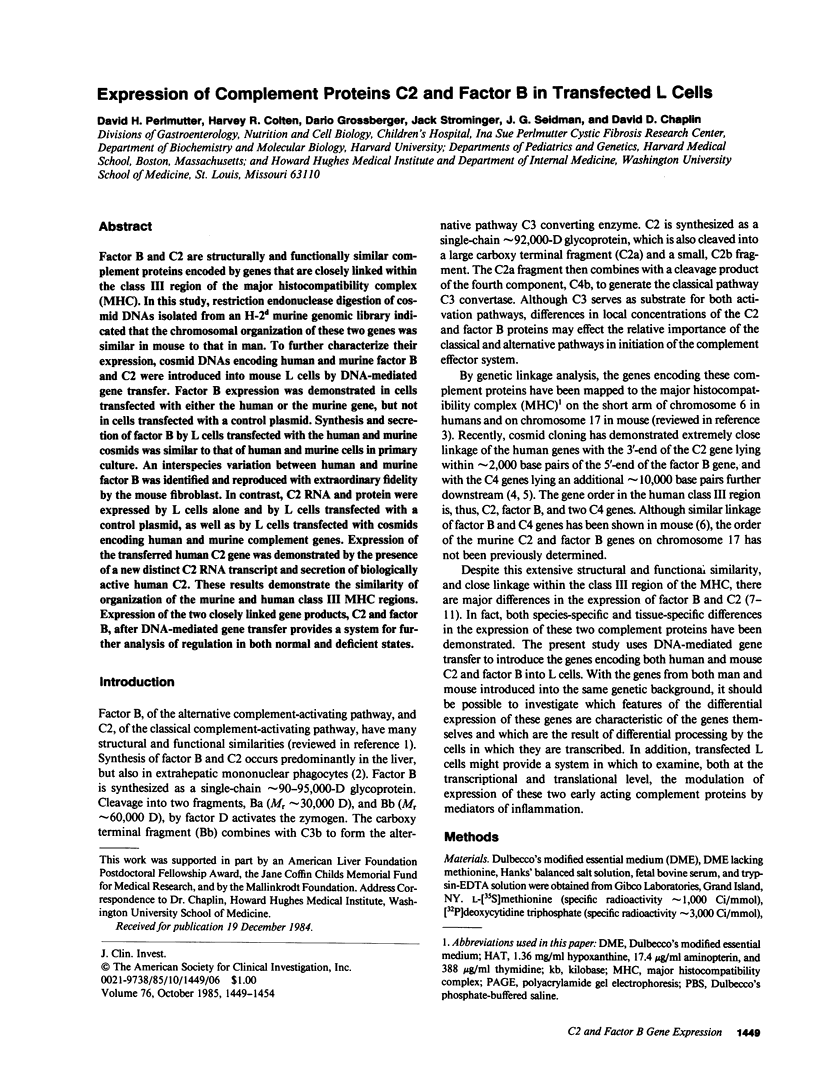
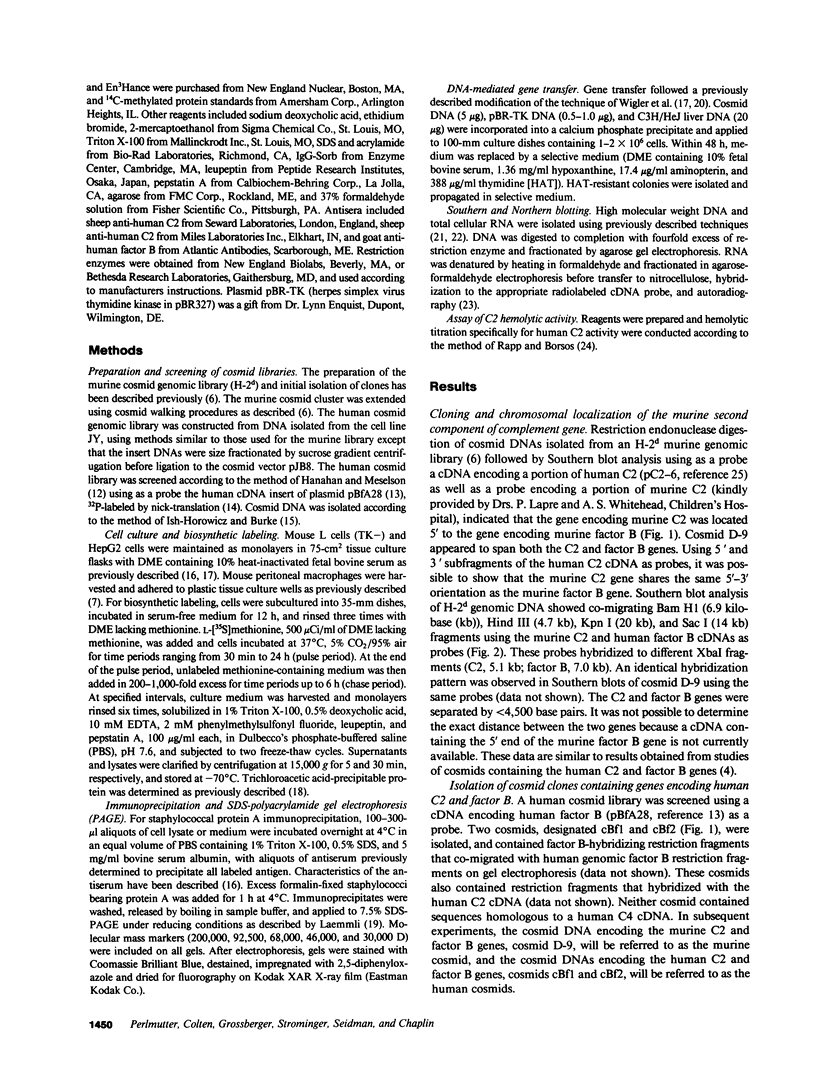
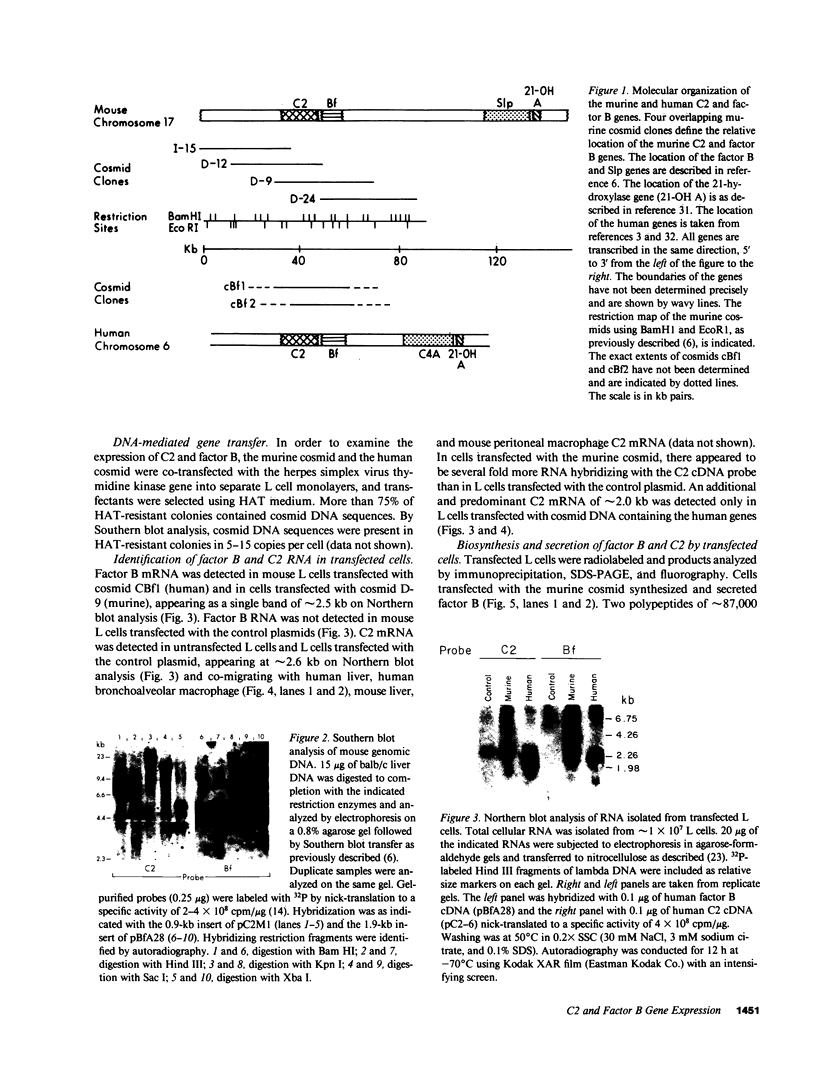
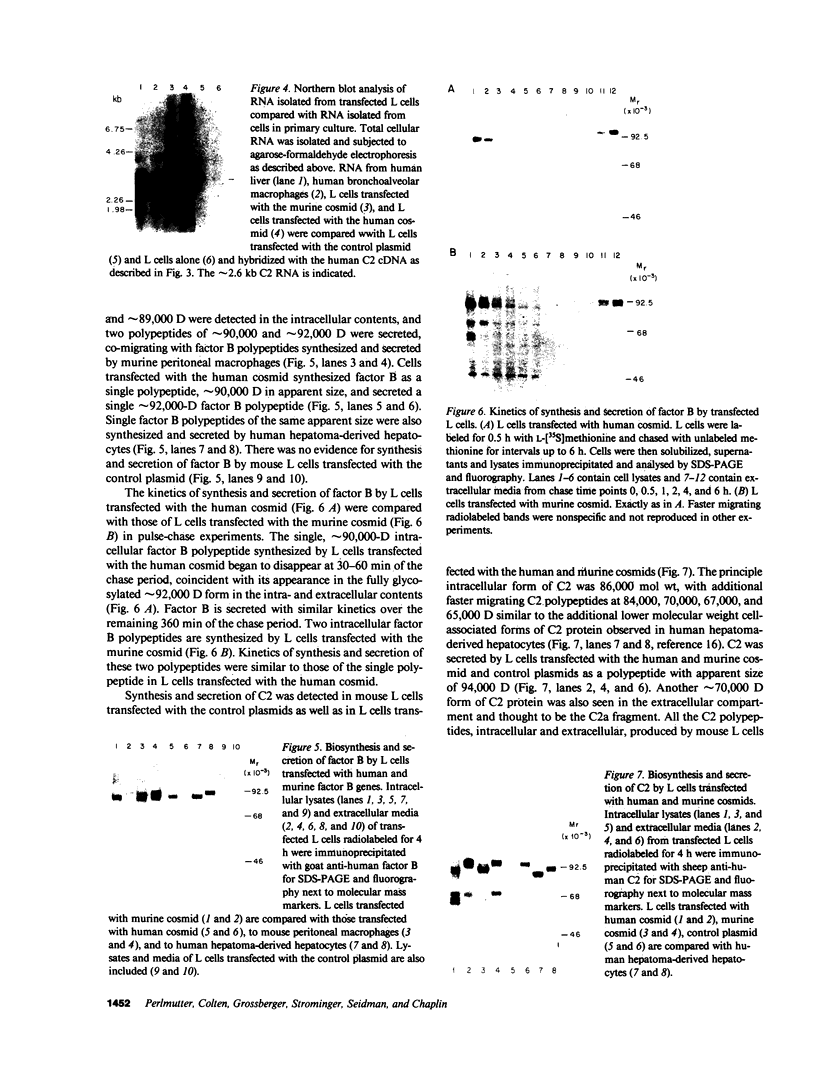
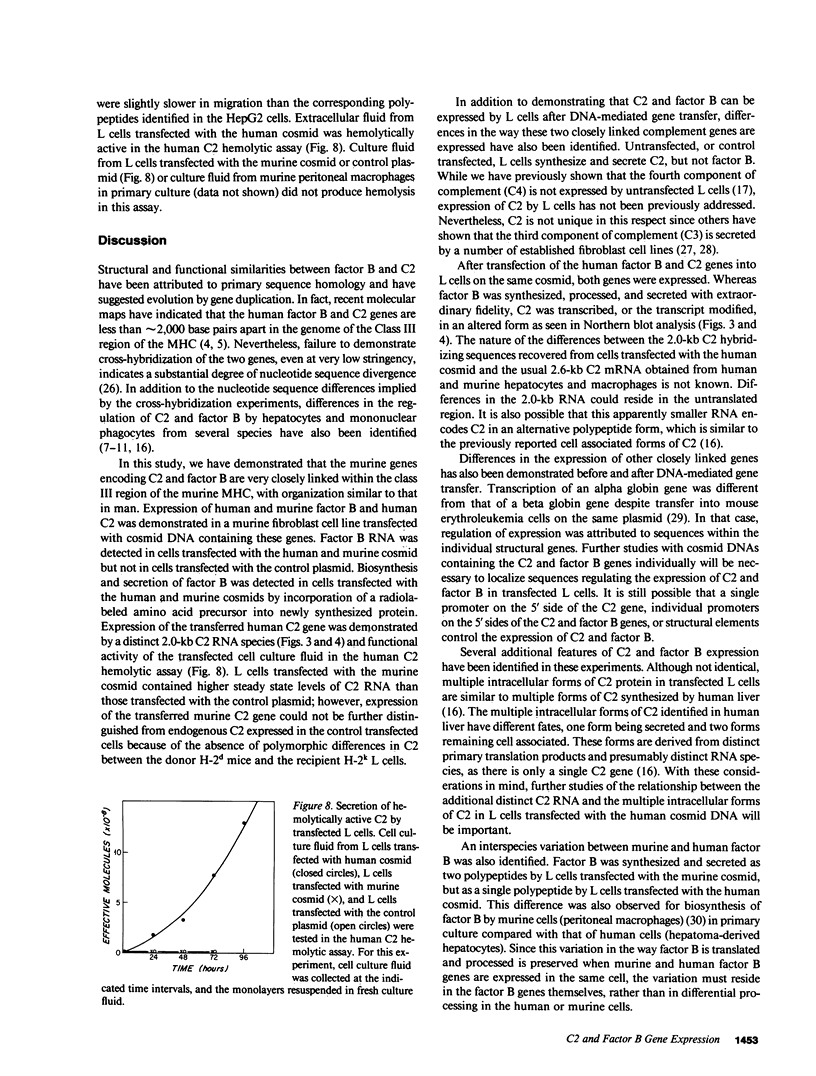
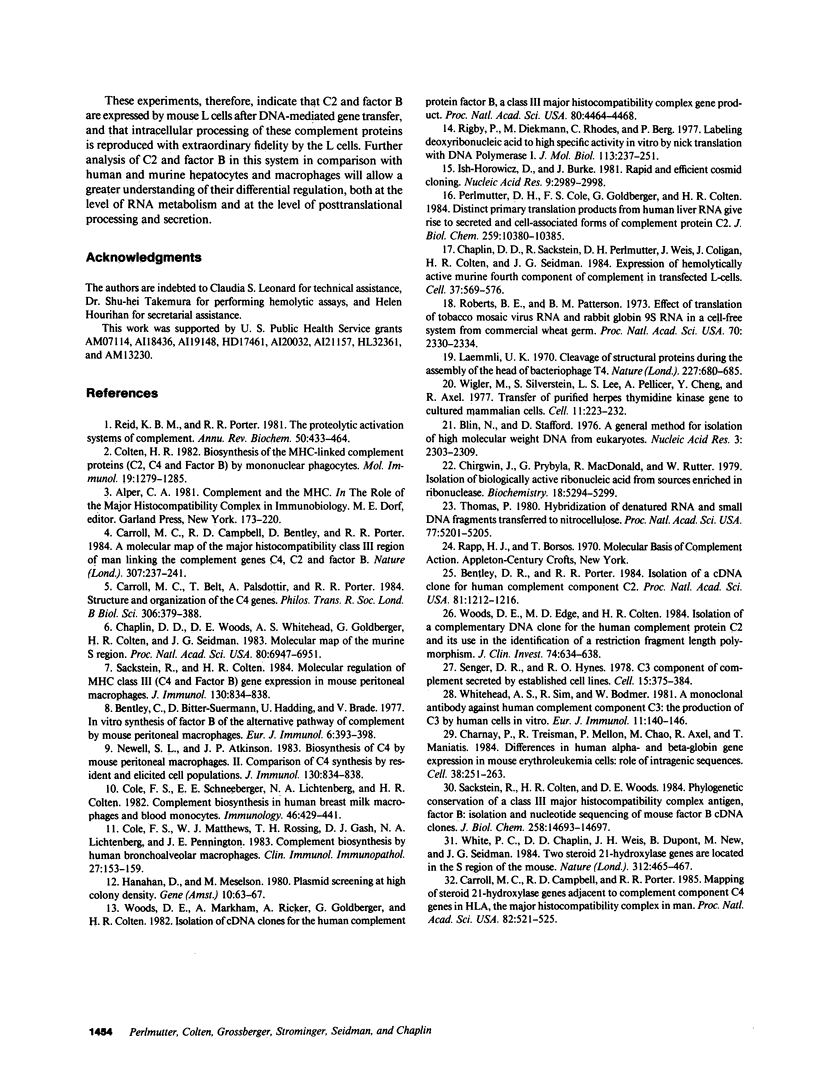
Images in this article
Selected References
These references are in PubMed. This may not be the complete list of references from this article.
- Bentley C., Bitter-Suermann D., Hadding U., Brade V. In vitro synthesis of factor B of the alternative pathway of complement activation by mouse peritoneal macrophages. Eur J Immunol. 1976 Jun;6(6):393–398. doi: 10.1002/eji.1830060604. [DOI] [PubMed] [Google Scholar]
- Bentley D. R., Porter R. R. Isolation of cDNA clones for human complement component C2. Proc Natl Acad Sci U S A. 1984 Feb;81(4):1212–1215. doi: 10.1073/pnas.81.4.1212. [DOI] [PMC free article] [PubMed] [Google Scholar]
- Blin N., Stafford D. W. A general method for isolation of high molecular weight DNA from eukaryotes. Nucleic Acids Res. 1976 Sep;3(9):2303–2308. doi: 10.1093/nar/3.9.2303. [DOI] [PMC free article] [PubMed] [Google Scholar]
- Carroll M. C., Belt T., Palsdottir A., Porter R. R. Structure and organization of the C4 genes. Philos Trans R Soc Lond B Biol Sci. 1984 Sep 6;306(1129):379–388. doi: 10.1098/rstb.1984.0098. [DOI] [PubMed] [Google Scholar]
- Carroll M. C., Campbell R. D., Bentley D. R., Porter R. R. A molecular map of the human major histocompatibility complex class III region linking complement genes C4, C2 and factor B. Nature. 1984 Jan 19;307(5948):237–241. doi: 10.1038/307237a0. [DOI] [PubMed] [Google Scholar]
- Carroll M. C., Campbell R. D., Porter R. R. Mapping of steroid 21-hydroxylase genes adjacent to complement component C4 genes in HLA, the major histocompatibility complex in man. Proc Natl Acad Sci U S A. 1985 Jan;82(2):521–525. doi: 10.1073/pnas.82.2.521. [DOI] [PMC free article] [PubMed] [Google Scholar]
- Chaplin D. D., Sackstein R., Perlmutter D. H., Weis J. H., Kruse T. A., Coligan J., Colten H. R., Seidman J. G. Expression of hemolytically active murine fourth component of complement in transfected L cells. Cell. 1984 Jun;37(2):569–576. doi: 10.1016/0092-8674(84)90387-8. [DOI] [PubMed] [Google Scholar]
- Chaplin D. D., Woods D. E., Whitehead A. S., Goldberger G., Colten H. R., Seidman J. G. Molecular map of the murine S region. Proc Natl Acad Sci U S A. 1983 Nov;80(22):6947–6951. doi: 10.1073/pnas.80.22.6947. [DOI] [PMC free article] [PubMed] [Google Scholar]
- Charnay P., Treisman R., Mellon P., Chao M., Axel R., Maniatis T. Differences in human alpha- and beta-globin gene expression in mouse erythroleukemia cells: the role of intragenic sequences. Cell. 1984 Aug;38(1):251–263. doi: 10.1016/0092-8674(84)90547-6. [DOI] [PubMed] [Google Scholar]
- Chirgwin J. M., Przybyla A. E., MacDonald R. J., Rutter W. J. Isolation of biologically active ribonucleic acid from sources enriched in ribonuclease. Biochemistry. 1979 Nov 27;18(24):5294–5299. doi: 10.1021/bi00591a005. [DOI] [PubMed] [Google Scholar]
- Cole F. S., Matthews W. J., Jr, Rossing T. H., Gash D. J., Lichtenberg N. A., Pennington J. E. Complement biosynthesis by human bronchoalveolar macrophages. Clin Immunol Immunopathol. 1983 May;27(2):153–159. doi: 10.1016/0090-1229(83)90065-x. [DOI] [PubMed] [Google Scholar]
- Cole F. S., Schneeberger E. E., Lichtenberg N. A., Colten H. R. Complement biosynthesis in human breast-milk macrophages and blood monocytes. Immunology. 1982 Jun;46(2):429–441. [PMC free article] [PubMed] [Google Scholar]
- Colten H. R. Biosynthesis of the MHC-linked complement proteins (C2, C4 and factor B) by mononuclear phagocytes. Mol Immunol. 1982 Oct;19(10):1279–1285. doi: 10.1016/0161-5890(82)90294-2. [DOI] [PubMed] [Google Scholar]
- Hanahan D., Meselson M. Plasmid screening at high colony density. Gene. 1980 Jun;10(1):63–67. doi: 10.1016/0378-1119(80)90144-4. [DOI] [PubMed] [Google Scholar]
- Ish-Horowicz D., Burke J. F. Rapid and efficient cosmid cloning. Nucleic Acids Res. 1981 Jul 10;9(13):2989–2998. doi: 10.1093/nar/9.13.2989. [DOI] [PMC free article] [PubMed] [Google Scholar]
- Laemmli U. K. Cleavage of structural proteins during the assembly of the head of bacteriophage T4. Nature. 1970 Aug 15;227(5259):680–685. doi: 10.1038/227680a0. [DOI] [PubMed] [Google Scholar]
- Newell S. L., Atkinson J. P. Biosynthesis of C4 by mouse peritoneal macrophages. II. Comparison of C4 synthesis by resident and elicited cell populations. J Immunol. 1983 Feb;130(2):834–838. [PubMed] [Google Scholar]
- Perlmutter D. H., Cole F. S., Goldberger G., Colten H. R. Distinct primary translation products from human liver mRNA give rise to secreted and cell-associated forms of complement protein C2. J Biol Chem. 1984 Aug 25;259(16):10380–10385. [PubMed] [Google Scholar]
- Reid K. B., Porter R. R. The proteolytic activation systems of complement. Annu Rev Biochem. 1981;50:433–464. doi: 10.1146/annurev.bi.50.070181.002245. [DOI] [PubMed] [Google Scholar]
- Rigby P. W., Dieckmann M., Rhodes C., Berg P. Labeling deoxyribonucleic acid to high specific activity in vitro by nick translation with DNA polymerase I. J Mol Biol. 1977 Jun 15;113(1):237–251. doi: 10.1016/0022-2836(77)90052-3. [DOI] [PubMed] [Google Scholar]
- Roberts B. E., Paterson B. M. Efficient translation of tobacco mosaic virus RNA and rabbit globin 9S RNA in a cell-free system from commercial wheat germ. Proc Natl Acad Sci U S A. 1973 Aug;70(8):2330–2334. doi: 10.1073/pnas.70.8.2330. [DOI] [PMC free article] [PubMed] [Google Scholar]
- Sackstein R., Colten H. R., Woods D. E. Phylogenetic conservation of a class III major histocompatibility complex antigen, factor B. Isolation and nucleotide sequencing of mouse factor B cDNA clones. J Biol Chem. 1983 Dec 10;258(23):14693–14697. [PubMed] [Google Scholar]
- Senger D. R., Hynes R. O. C3 component of complement secreted by established cell lines. Cell. 1978 Oct;15(2):375–384. doi: 10.1016/0092-8674(78)90006-5. [DOI] [PubMed] [Google Scholar]
- Thomas P. S. Hybridization of denatured RNA and small DNA fragments transferred to nitrocellulose. Proc Natl Acad Sci U S A. 1980 Sep;77(9):5201–5205. doi: 10.1073/pnas.77.9.5201. [DOI] [PMC free article] [PubMed] [Google Scholar]
- White P. C., Chaplin D. D., Weis J. H., Dupont B., New M. I., Seidman J. G. Two steroid 21-hydroxylase genes are located in the murine S region. 1984 Nov 29-Dec 5Nature. 312(5993):465–467. doi: 10.1038/312465a0. [DOI] [PubMed] [Google Scholar]
- Whitehead A. S., Sim R. B., Bodmer W. F. A monoclonal antibody against human complement component C3: the production of C3 by human cells in vitro. Eur J Immunol. 1981 Feb;11(2):140–146. doi: 10.1002/eji.1830110215. [DOI] [PubMed] [Google Scholar]
- Wigler M., Silverstein S., Lee L. S., Pellicer A., Cheng Y. c., Axel R. Transfer of purified herpes virus thymidine kinase gene to cultured mouse cells. Cell. 1977 May;11(1):223–232. doi: 10.1016/0092-8674(77)90333-6. [DOI] [PubMed] [Google Scholar]
- Woods D. E., Edge M. D., Colten H. R. Isolation of a complementary DNA clone for the human complement protein C2 and its use in the identification of a restriction fragment length polymorphism. J Clin Invest. 1984 Aug;74(2):634–638. doi: 10.1172/JCI111461. [DOI] [PMC free article] [PubMed] [Google Scholar]





